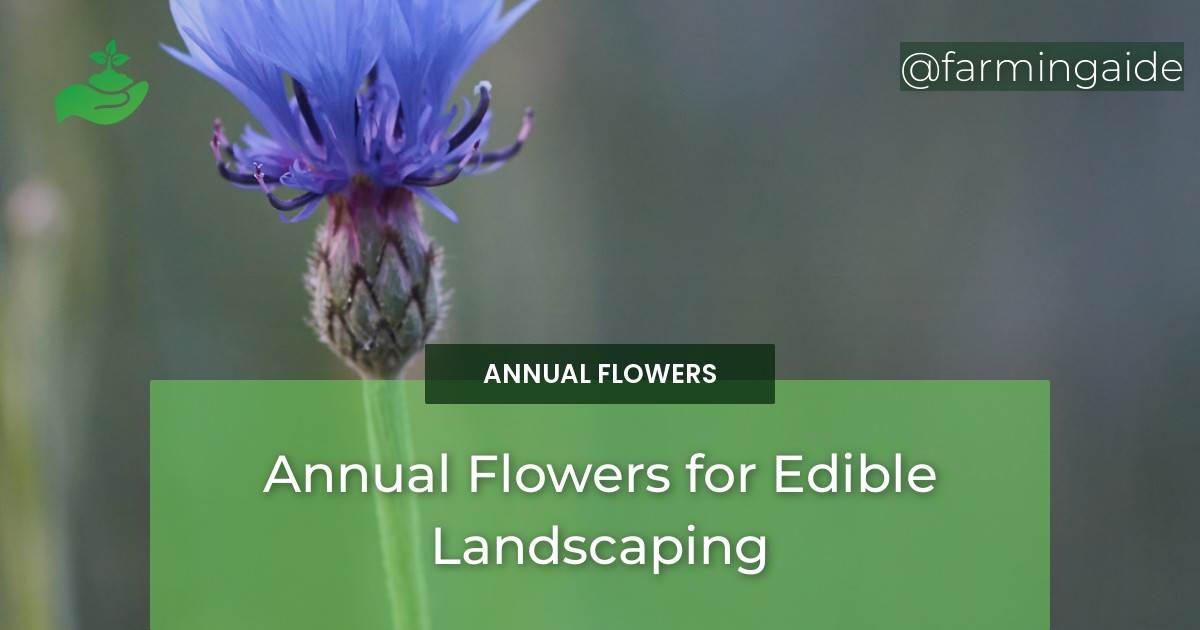Edible landscaping is a beautiful and unique way to grow food and flowers together in the same garden. Not only does this approach provide fresh produce, but it also adds aesthetic appeal to your landscape. One way to achieve this is by incorporating annual flowers into your edible landscaping. In this article, we’ll discuss the benefits of using annual flowers, factors to consider when choosing them, and examples of edible annual flowers that you can use in your garden. We’ll also explore how to use annual flowers in edible landscaping, including companion planting, culinary uses, and decorative uses.
Why Choose Annual Flowers for Edible Landscaping
Benefits of Annual Flowers in Edible Landscaping
Annual flowers are a great addition to any edible landscape. Here are some benefits of using annual flowers:
- They are easy to grow and maintain
- They provide a quick burst of color and beauty to your garden
- They attract pollinators, such as bees and butterflies
- They can help deter pests and attract beneficial insects
Factors to Consider When Choosing Annual Flowers for Edible Landscaping
When selecting annual flowers for your edible landscape, there are a few things to keep in mind:
- Choose flowers that complement the overall design of your landscape
- Consider the growing conditions, such as sunlight and soil type
- Make sure the flowers you choose are safe to eat
Examples of Edible Annual Flowers
Nasturtium
Nasturtiums are a popular choice for edible landscaping. These brightly colored flowers have a peppery taste and can be used in salads, sandwiches, and as a garnish. They also attract aphids away from your other plants, making them a great companion plant.
Marigold
Marigolds are another beautiful addition to any edible landscape. The flowers have a citrusy flavor and can be used in salads, soups, and rice dishes. They also have natural pest control properties and can help repel nematodes and other harmful insects.
Calendula
Calendula, also known as pot marigold, is a versatile flower that can be used in a variety of ways. The bright orange and yellow flowers have a slightly bitter taste and can be used in salads, teas, and as a natural food coloring. They also have anti-inflammatory properties and can be used topically to soothe skin irritations.
Viola
Violas are a delicate and beautiful flower that can be used in salads, as a garnish, or to decorate cakes. They come in a variety of colors and have a subtle, sweet flavor. They also attract beneficial insects, such as ladybugs and lacewings, to your garden.
Pansy
Pansies are another popular choice for edible landscaping. These colorful flowers have a slightly sweet and grassy flavor and can be used in salads, as a garnish, or to decorate cakes. They also attract beneficial insects, such as bees and hoverflies, to your garden.
Dianthus
Dianthus, also known as sweet William, are a fragrant and beautiful addition to any garden. The flowers have a sweet and spicy flavor and can be used in salads or as a garnish. They also attract beneficial insects, such as butterflies and moths, to your garden.
How to Use Annual Flowers in Edible Landscaping
Companion Planting with Annual Flowers
Companion planting is the practice of planting different crops together in order to improve growing conditions and deter pests. Annual flowers can be great companion plants for your edible crops. For example:
- Plant marigolds near tomatoes to deter nematodes
- Plant nasturtiums near cucumbers to deter aphids
- Plant dianthus near strawberries to improve their flavor
Culinary Uses of Annual Flowers
Annual flowers not only add visual appeal to your dishes, but they also add flavor and nutrition. Some ways to use annual flowers in your cooking include:
- Add nasturtiums to your salads for a peppery kick
- Use calendula petals to add color and flavor to soups and stews
- Use pansies and violas to decorate cakes and desserts
Decorative Uses of Annual Flowers
Annual flowers can also be used purely for decorative purposes. Here are some ideas:
- Use nasturtiums to brighten up your garden beds or hanging baskets
- Decorate your patio or deck with pots of marigolds or dianthus
- Create a colorful centerpiece for your table using pansies and violas
How can I Use Annual Flowers for Edible Landscaping as Ground Covers?
Annual flowers ground covers usage can be a great option for edible landscaping. Selecting fast-growing annuals like nasturtiums or calendula can provide attractive ground cover while also adding a pop of color to your landscape. These flowers are not only visually appealing but also edible, making them a practical choice for both beauty and function.
Conclusion
Annual flowers are a great addition to any edible landscape. They provide beauty, nutrition, and natural pest control properties. By selecting the right flowers and using them in creative ways, you can create a stunning and functional garden that provides both food and visual appeal.


